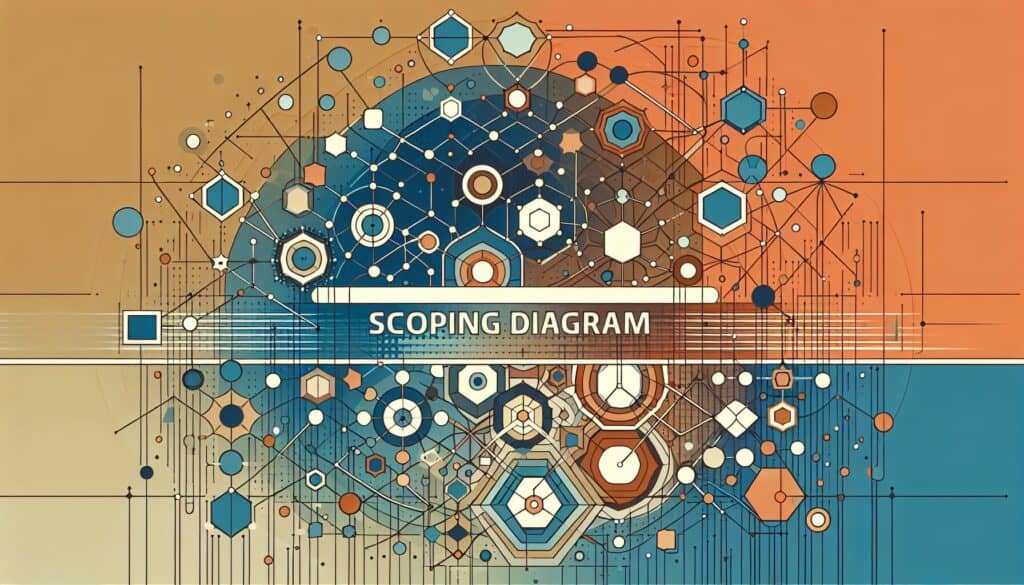To define the boundaries of a process or system under review, showing its interactions with external entities.
- المنهجيات: العملاء والتسويق, الاقتصاد, تصميم المنتج
Scoping Diagram

Scoping Diagram
- المنهجية الرشيقة, التحسين المستمر, التفكير التصميمي, تخطيط العمليات, إدارة المشاريع, إدارة الجودة, لغة نمذجة النظم (SysML), تخطيط مسار القيمة
الهدف:
كيفية استخدامه:
- A high-level visual tool that places the process or system "in scope" at the center and illustrates its inputs from and outputs to stakeholders, other processes, or systems. It helps clarify what is included and excluded from a project or analysis.
الايجابيات
- Clearly defines project or process boundaries; Helps identify key stakeholders and interfaces; Facilitates common understanding among team members; Useful for initial analysis and problem definition.
سلبيات
- Provides a high-level view and lacks internal details; Can oversimplify complex interactions if not used carefully; The definition of "scope" can still be debated despite the diagram.
الفئات:
- حل المشكلات, تصميم المنتج, إدارة المشاريع
الأفضل لـ
- Establishing a clear understanding of what a project or process analysis will cover and what it will not, by visualizing its external connections.
The Scoping Diagram serves as an integral tool in various stages of product design and engineering, particularly during the initial phases of project definition and requirement gathering, where clarity of scope is paramount. It finds applications across industries such as automotive, aerospace, consumer electronics, and healthcare, where complex systems and multiple stakeholders are involved. By visually mapping out the relationships between the central process or system and its external elements, stakeholders can easily identify essential interfaces, dependencies, and the boundaries of the project. Engaging participants such as project managers, engineers, designers, and even end-users in this visualization activity can facilitate a collaborative environment, fostering a shared understanding of the project’s focus. This method proves valuable during workshops or brainstorming sessions aimed at framing project objectives or analyzing أداء العملية, allowing teams to clarify expectations and potentially identify areas for innovation. The visual representation aids in differentiating between what will be included in the scope and what will be explicitly excluded, thus preventing scope creep later in development. Clarity in defining these boundaries accelerates decision-making processes and helps teams avoid miscommunications that may arise during subsequent project phases.
الخطوات الرئيسية لهذه المنهجية
- Identify the main process or system to be scoped.
- Outline the key stakeholders involved with the process or system.
- Determine the inputs required from stakeholders and other systems.
- Define the expected outputs and deliverables to stakeholders and systems.
- Visualize the connections between the process or system and its external elements.
- Specify the boundaries and limits of the project or analysis.
- Review and refine the diagram with stakeholder feedback for accuracy.
- Finalize the scoping diagram for use in project planning and communication.
نصائح للمحترفين
- Involve cross-functional team members in scoping sessions to leverage diverse viewpoints, ensuring comprehensive coverage of all relevant areas.
- Utilize iterative revisions of the Scoping Diagram during project phases to incorporate evolving insights and maintain alignment with stakeholder needs.
- Document assumptions and limitations adjacent to the Scoping Diagram for transparency, enabling informed decision-making throughout the project lifecycle.
لقراءة عدة منهجيات ومقارنتها, نوصي باستخدام
> مستودع المنهجيات الشامل <
مع أكثر من 400 منهجية أخرى.
نرحب بتعليقاتكم على هذه المنهجية أو المعلومات الإضافية على قسم التعليقات أدناه ↓، وكذلك أي أفكار أو روابط متعلقة بالهندسة.
السياق التاريخي
1949
1950
1950
1960
1960
1960
1960
1940
1950
1950
1958
1960
1960
1960
1960
(إذا كان التاريخ غير معروف أو غير ذي صلة، على سبيل المثال "ميكانيكا الموائع"، يتم تقديم تقدير تقريبي لظهوره الملحوظ)















منشورات ذات صلة
استبيانات الانزعاج العضلي الهيكلي
الاختبار متعدد المتغيرات (MVT)
تحليل الانحدار المتعدد
أنظمة التقاط الحركة
طريقة MoSCoW
اختبار متوسط المزاج